 previous article in this issue previous article in this issue | next article in this issue  |

|
Document Details : Title: Jérusalem et l'Arménie cilicienne Author(s): MUTAFIAN, Claude Journal: Revue des Études Arméniennes Volume: 39 Date: 2020 Pages: 287-301 DOI: 10.2143/REA.39.0.3288975 Abstract : When the Crusaders entered Asia Minor at the end of the 11th century, they met the large Armenian Community settled in Cappadocia and Cilicia. After the capture of Jerusalem in 1099 and the foundation of four Latin States, Armeno-frankish relations became very important, in spite of the religious problems due to the rejection of Chalcedon by the Armenians. As an example, intermarriages became frequent, and the two first queens of Jerusalem were Armenian princesses. The third one, the famous Melisende, had an Armenian mother. These Latin dynasties had close relations with the Rubinian princes, who soon controlled most of Cilicia, and with the Armenian catholicos. The loss of Jerusalem in 1187 provoked the Third Crusade, which led in 1198 to the foundation of two new Christian Kingdoms, Latin Cyprus and Cilicia Armenian. The irruption of the Mongols opened a new chapter but did not affect Armenian relations with Jerusalem. The Armenians integrated the Mongol army which defeated twice the Mamelukes and entered in Jerusalem in the second half of the 13th century. The 14th century marked the decadence of Cilician Armenia, but Jerusalem remained as a myth. When the Mamelukes put an end to the Kingdom, in 1375, the last King, Leo V, was taken prisoner to Cairo, with his family and the former Queen Mary of Korykos, whose last will was to finish her life in the Holy City. She got the authorization from the sultan. |
|
